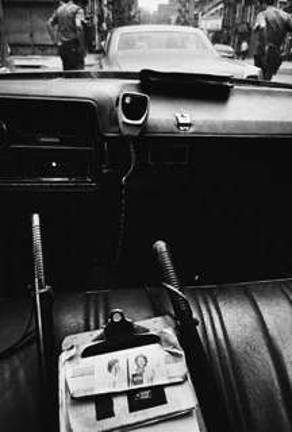Cops and Blotters: Looking Behind the Scene of a Crime

In 1972, the photographer Leonard Freed set out to document the daily lives of New York City police officers. He wanted to humanize the police force, arguing that "if we do not concern ourselves with who the police are-who they really are?we run the real risk of finding that we no longer have public servants who are required to protect the public." Freed's work is on view at the Museum of the City of New York in an exhibition titled Police Work: Photographs by Leonard Freed, 1972-1979. Unfortunately, Freed, in this collection from a period in New York's most dire and corrupt era, didn't bother to humanize the New Yorkers who dealt with the police every day. The result is a series of compelling but oddly cartoonish photos of the city in its crime-ridden heyday. Freed is at his best when he shows us the police on their own territory. I lingered over a series of off-duty cops: a policewoman sits on her motorcycle with her little boy and girl next to her; a policeman dressed in full Civil War regalia stands with his daughters and their dolls. Freed doesn't give us a location, but both photos look like they were taken in the semi-rural suburbs, at a healthy remove from the crumbling city. Looking at them is like looking through the wrong end of a telescope into a neat, private little world. Even Freed's group portrait at a station house has this self-contained look. The officers stare calmly at the camera, giving nothing away. If there is any anger in their hearts or any sorrow, Freed hasn't captured it. When the cops go out to the streets they are confronted with a dirty, dangerous city. Some of that dirt and danger comes across in the photographs. There are corpses lying in stairwells, men showing off their scars and fields of rubble around abandoned buildings. But Freed 's photos are primarily portraits of the police, with the city acting as background. An officer with a fatherly smile points a gun at two suspects whose faces are to the wall. Two young policemen chat while a prostitute, again with her back to the camera, lounges across two chairs. Another photo shows a young policeman in the station house, putting on a bulletproof vest. He looks alert and excited; an eager young hero. The caption reads, "We're going to pick up a murder suspect." But what about the suspect he's apprehending? What does he look like and what does he want to say? Nobody can do it all, and I wouldn't blame Freed for neglecting the city's civilians if it wasn't for his desperate urge to get cute. There are some goofy photos here, for example of a tall woman kissing a short cop on the cheek ("Isn't he cute?" the caption reads) and a policewoman playing Duck Duck Goose with children. The Museum of the City of New York, which sometimes looks at New York City through Mickey Mouse glasses, shares some of the blame for choosing to include this kind of schmaltz in such a small show. Still, the exhibit is well worth seeing. Look over the policemen's heads, past the images that Freed wants to show you, and focus on the city itself. Police Work: Photographs by Leonard Freed, 1972-1979 Through May 6, Museum of the City of New York, 1220 5th Ave., 212-534-1672, www.mcny.org. This article first appeared in the March 7 issue of CityArts. For more from New York's Review of Culture, visit www.cityartsnyc.com.